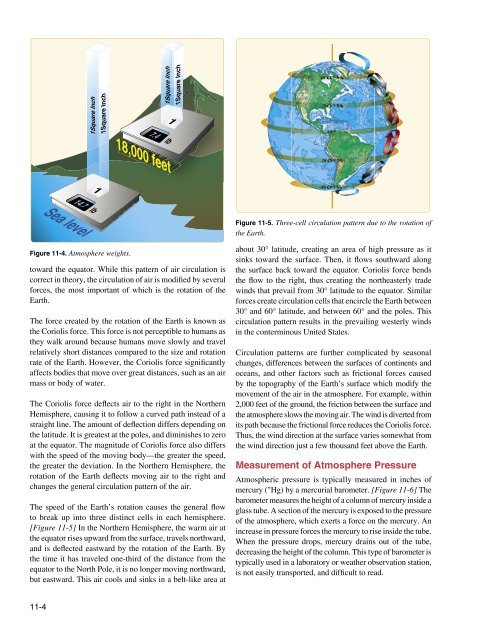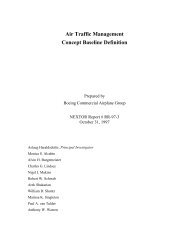Chapter 11: Weather Theory - FAA
Chapter 11: Weather Theory - FAA
Chapter 11: Weather Theory - FAA
Create successful ePaper yourself
Turn your PDF publications into a flip-book with our unique Google optimized e-Paper software.
14.7 lb1Square Inch1Square Inch1Square Inch<strong>11</strong>Square Inch18,000 feet7.4 lb1Sea levelFigure <strong>11</strong>-5. Three-cell circulation pattern due to the rotation ofthe Earth.Figure <strong>11</strong>-4. Atmosphere weights.toward the equator. While this pattern of air circulation iscorrect in theory, the circulation of air is modified by severalforces, the most important of which is the rotation of theEarth.The force created by the rotation of the Earth is known asthe Coriolis force. This force is not perceptible to humans asthey walk around because humans move slowly and travelrelatively short distances compared to the size and rotationrate of the Earth. However, the Coriolis force significantlyaffects bodies that move over great distances, such as an airmass or body of water.The Coriolis force deflects air to the right in the NorthernHemisphere, causing it to follow a curved path instead of astraight line. The amount of deflection differs depending onthe latitude. It is greatest at the poles, and diminishes to zeroat the equator. The magnitude of Coriolis force also differswith the speed of the moving body—the greater the speed,the greater the deviation. In the Northern Hemisphere, therotation of the Earth deflects moving air to the right andchanges the general circulation pattern of the air.The speed of the Earth’s rotation causes the general flowto break up into three distinct cells in each hemisphere.[Figure <strong>11</strong>-5] In the Northern Hemisphere, the warm air atthe equator rises upward from the surface, travels northward,and is deflected eastward by the rotation of the Earth. Bythe time it has traveled one-third of the distance from theequator to the North Pole, it is no longer moving northward,but eastward. This air cools and sinks in a belt-like area atabout 30° latitude, creating an area of high pressure as itsinks toward the surface. Then, it flows southward alongthe surface back toward the equator. Coriolis force bendsthe flow to the right, thus creating the northeasterly tradewinds that prevail from 30° latitude to the equator. Similarforces create circulation cells that encircle the Earth between30° and 60° latitude, and between 60° and the poles. Thiscirculation pattern results in the prevailing westerly windsin the conterminous United States.Circulation patterns are further complicated by seasonalchanges, differences between the surfaces of continents andoceans, and other factors such as frictional forces causedby the topography of the Earth’s surface which modify themovement of the air in the atmosphere. For example, within2,000 feet of the ground, the friction between the surface andthe atmosphere slows the moving air. The wind is diverted fromits path because the frictional force reduces the Coriolis force.Thus, the wind direction at the surface varies somewhat fromthe wind direction just a few thousand feet above the Earth.Measurement of Atmosphere PressureAtmospheric pressure is typically measured in inches ofmercury ("Hg) by a mercurial barometer. [Figure <strong>11</strong>-6] Thebarometer measures the height of a column of mercury inside aglass tube. A section of the mercury is exposed to the pressureof the atmosphere, which exerts a force on the mercury. Anincrease in pressure forces the mercury to rise inside the tube.When the pressure drops, mercury drains out of the tube,decreasing the height of the column. This type of barometer istypically used in a laboratory or weather observation station,is not easily transported, and difficult to read.<strong>11</strong>-4
















